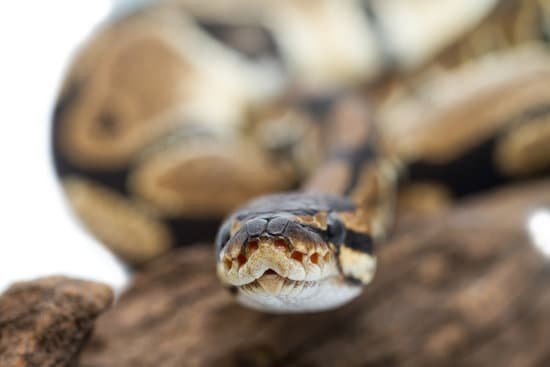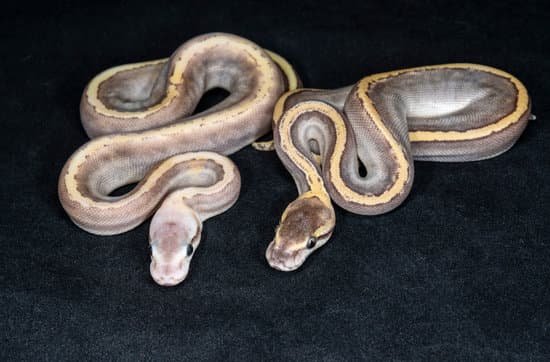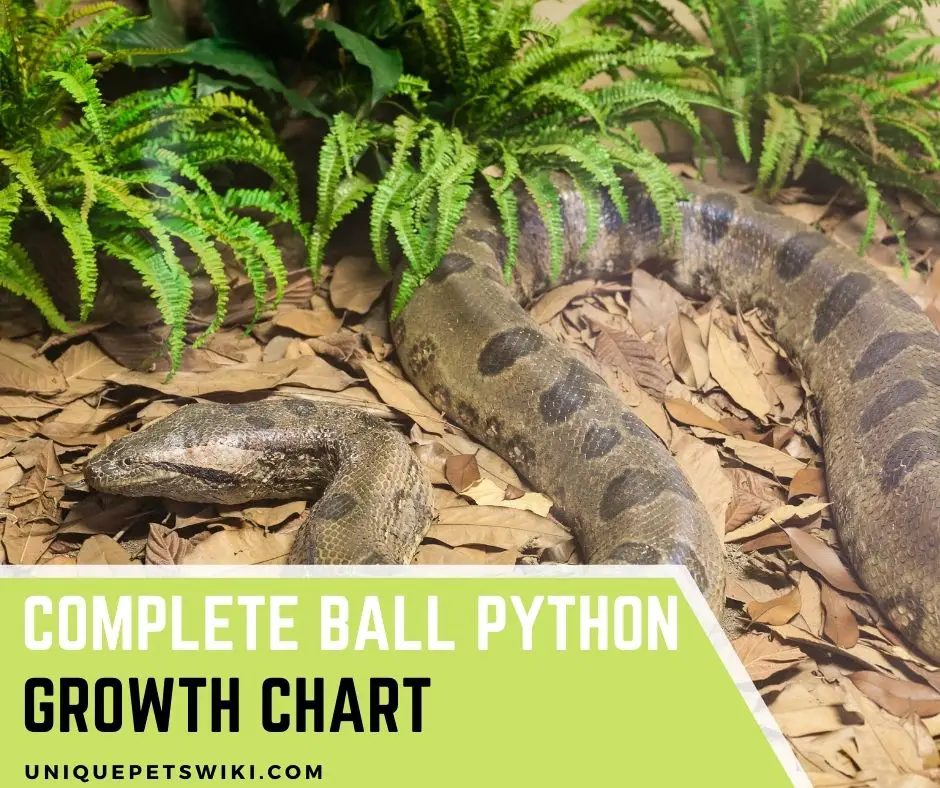This article is tailored to give you credible information you need to know about ball python growth chart and growth pattern.
Do not leave anything to chance, not even the growth rate and health of your pet ball python. Ball pythons, while still young, are fast growers. They grow at an individual rate at specific ages.
All things being equal, they can reach maturity within 3-5 years. If you’re not familiar with their growth pattern and what could affect their growth rate, it’ll be challenging to detect when your ball python isn’t alright.
This consciousness will prompt you to keep a weekly record of its weight and length. To find out ball pythons’ growth rate from hatchlings until when they die in old age, keep reading.
This article has been reviewed by Dr. Gospel. Read more about our knowledge control process here.
Contents
The Complete Growth Chart For Your Ball Pythons

Does it matter knowing the growth rate of your ball pythons? I would say yes, it does. Let’s check out our ball python growth chart for more details.
As a good breeder, at some point when your ball pythons aren’t weighing or measuring as supposed to, a good knowledge of how fast they grow and at what point of their lives they grow slowly will help you to figure out when something is wrong with them.
Generally, ball pythons in captivity grow at different rates. The growth rates will depend on factors such as your snakes’ health and eating habits, and your husbandry. If any of these factors are negative, it’ll show in your snakes’ size.
For an average steady ball pythons growth, all factors must be good. Note that the weight and length of the growth chart presented in this article are the average ball pythons would get to.
As mentioned earlier, what exactly your ball python will weigh and measure may differ slightly.
| Age | Ball python weight(g) | Size in length(inches) | Food size(grams) |
| 1 week(Hatchlings) | 45-100 | 10-16 | Pinky rat or Hopper mouse. |
| 2 weeks | 45-100 or more | 16-20 | Pinky rat or Hopper mouse. |
| 1 month | 60-105 | 20-27 | Pinky rat or Hopper mouse. |
| 2 months | 80-130 | 20-27 | Pinky rat or Hopper mouse. |
| 4 months | 200-270 | 20-27 | Rat fuzzy or small mouse. |
| 6 months | 300-360 | 20-27 | Rat pup or adult mouse. |
| 9 months | 450-470 | 25-40 | Weaned rat or jumbo mouse. |
| 12 months | 500-1000 | 2 feet | Small rat or 2-3 adult mice. |
| 1.5 years | 600-1800 | 2 feet | Medium size rat or 2 small rate or 4-5 adult mice. |
| 2 years | 800-1800 | 2.5-3.5 feet | Medium size rat or 2 small rate or 4-5 adult mice |
| 3 years | 1200-1800 | 3-5 feet | Medium size rat or 2 small rate or 4-5 adult mice |
| 5 years | 1800-2300 | 4-6 feet(6 feet are rare cases) | Medium size rat or 2 small rate or 4-5 adult mice |
How Fast Do Baby (hatched) Ball Pythons Grow?
Baby or hatched ball pythons are fast growers. They will grow fast in their first few months if you provide nutritious foods regularly. Ball pythons that are classified as babies are those between their first meal and three months.
- 1- 3 months = hatchlings
- 3months – 1yr = Juvenile
- 1-3 yrs = sub adults
When baby ball pythons are hatched, they do not start eating immediately. They only start eating after their first shed. This usually takes place within the early 5-10 days after they’re born.
At birth, ball python hatchlings (that is, those before first shed) measure 10-16 inches long and weigh 40-75g. Within a short period of 1 month, when they’ve started eating, they should measure about 16-27 inches and weigh 75 to 105g.
Figures are relative: Some hatchlings can weigh as much as 110g immediately after hatching.
Many breeders who want their ball pythons to grow fast do power feed their snakes. Perhaps these breeders are misinformed by what they read on the Internet to be the ideal size of ball pythons at certain ages.
That information, such as the one in this article is average sizes. How fast your ball python will grow and what exactly it’ll measure or weigh will be determined by some factors such as husbandry, feeding, and health.
That said, do not force feed your ball python. Give it time to grow naturally.
How Fast Do Juvenile Ball Pythons Grow?
As juveniles, they grow at the same speed as the babies. From 6 months to 1 year is when ball pythons are considered juveniles. They would measure between 20 to 40 inches and weigh between 300 to 1000g.
When Do Ball Pythons Stop Growing?
Ball pythons never stop growing. As they get older, their growth rate may reduce but will not completely stop. Their fastest growth rate is noticed during the first few months after they’re born.
This is usually between 1-months to 3 years of their lives. During this fastest growth period, ball pythons will get to their overall length. That is, they will attain the length they would ever get to.
After this period, they’ll only keep adding a few inches or a fraction of an inch to their length.
Learn proper care for your ball pythons
Last update on 2022-12-29 / Affiliate links / Images from Amazon Product Advertising API
The book includes the complete care guide for ball pythons as pets. It would be good for beginners and experienced owners.
Can I Breed My Ball Python After They Reach Adult Size?

Depending on your definition of “adult size”. The answer is NO! Ball pythons usually grow faster than age. Some might reach the adult size but still be juvenile.
It is better to consider the age in year(s) alongside their weight before breeding them. Weight or length alone doesn’t determine size. Neither does age alone determine sexual maturity for ball pythons.
That said, none of those factors should be considered in isolation when deciding to breed your ball pythons. To successfully breed your ball pythons, all the factors above must be taken into consideration.
They must be fit in terms of age and weight to be bred. Being that ball pythons are sexually dimorphic, their age and size requirements for breeding aren’t the same.
Males attain maturity faster than females. Thus, you can breed your male ball python once it reaches 700g and is about 12 months old. Once they get to 1200g and are at least 2years, the females are ready to breed.
Read more on Ball Python Breeding here.
Can I Use This Growth Chart For Other Pet Snakes?
NO, every species of snake has its unique growth rate. It takes different species of snakes at different rates to get to adult size and weight. Some may be the same with ball pythons, but many are not.
Besides, ball pythons are classified as small-sized pet snakes. Other species are way longer and larger on average than ball pythons. Thus, using ball python’s growth chart for other pet snakes would be misleading.
That said, while it takes three years for ball pythons to get to adult size or breeding maturity where it measures between 3-5 feet, it takes corn and bull snakes two years to attain an adult size of 4-6 feet.
Boa constrictors and Stimson’s python, on the other end, get to adult size between 3-5 years. At this age, they measure between 8-10 feet.
Wrapping Up
Note that all ball pythons are not the same. They differ in genetic make-up, habitat, eating habits, and husbandry.
All of these factors are key influencers to how fast they will grow. A healthy ball python may still not weigh up to the value stated here. In that case, it’s not advisable to power feed the snake.
What should be your paramount concern is that all captive conditions are kept normal to replicate the wild.
However, in situations where the weight and length are way below average, you may need to take your pet to the vet.

